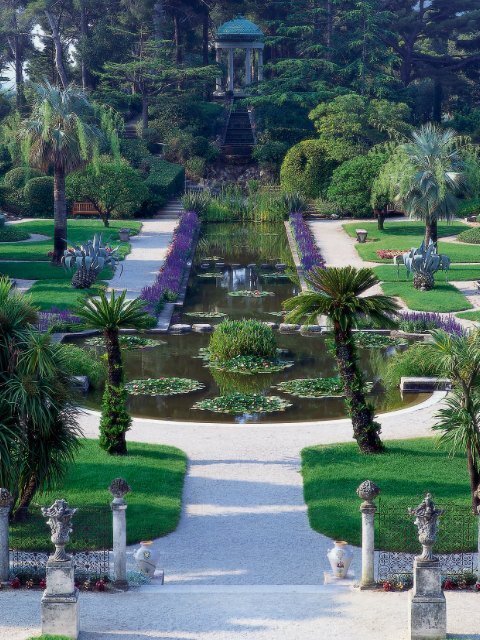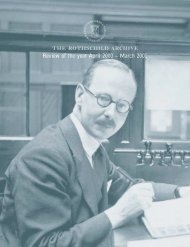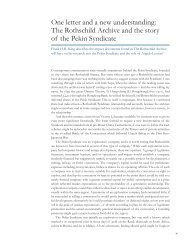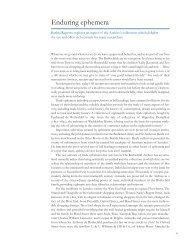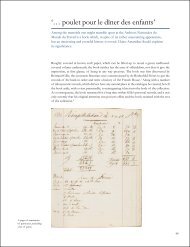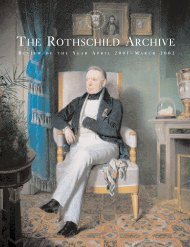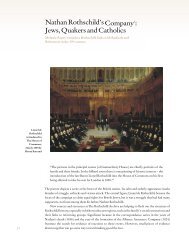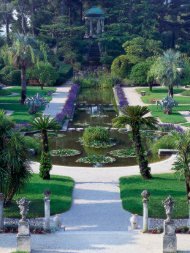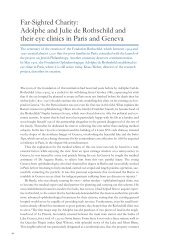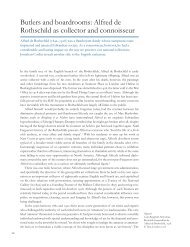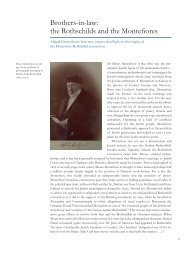Beatrice Ephrussi de Rothschild: creator and collector
Beatrice Ephrussi de Rothschild: creator and collector
Beatrice Ephrussi de Rothschild: creator and collector
Create successful ePaper yourself
Turn your PDF publications into a flip-book with our unique Google optimized e-Paper software.
Béatrice <strong>Ephrussi</strong> <strong>de</strong> <strong>Rothschild</strong>:<br />
<strong>creator</strong> <strong>and</strong> <strong>collector</strong><br />
Dr Ulrich Leben, a member of the research team exploring the contributions<br />
ma<strong>de</strong> by members of the <strong>Rothschild</strong> family to the cultural life of France, presents<br />
a summary of the life <strong>and</strong> collections of Béatrice <strong>Ephrussi</strong> <strong>de</strong> <strong>Rothschild</strong>.<br />
opposite<br />
The Temple of Love in<br />
the gar<strong>de</strong>ns at the Musée<br />
<strong>Ephrussi</strong> <strong>Rothschild</strong>.<br />
(Lionel <strong>de</strong> <strong>Rothschild</strong>)<br />
I hereby bequeath to the Institut <strong>de</strong> France, for the Académie <strong>de</strong>s Beaux-Arts, the Villa Ile <strong>de</strong> France,<br />
in Saint Jean Cap Ferrat, together with all the works of art <strong>and</strong> furniture, <strong>and</strong> the gar<strong>de</strong>ns surrounding the<br />
villa, for the purposes of creating a museum … To this new museum, I bequeath all my works of art, whether<br />
in Paris, 19, avenue Foch, or in the Villa Soleil <strong>and</strong> the Villa Rose <strong>de</strong> France in Monte Carlo: paintings,<br />
furniture, porcelain, tapestry, etc. It is my wish that as much as possible the museum keeps its current<br />
appearance as a salon, <strong>and</strong> that the valuable pieces are kept behind glass.<br />
Thus read the clause in Béatrice <strong>Ephrussi</strong> <strong>de</strong> <strong>Rothschild</strong>’s will, which secured the future of her<br />
art collection, now in the legendary Musée <strong>Ephrussi</strong> <strong>Rothschild</strong> on the Cote d’Azur. However,<br />
<strong>de</strong>spite thous<strong>and</strong>s of visitors to the villa every year, by <strong>Rothschild</strong> st<strong>and</strong>ards comparatively little<br />
is known of the extraordinary woman who <strong>de</strong>vised this collection <strong>and</strong> its setting. By piecing<br />
together small <strong>de</strong>tails from various sources a more vivid picture of Béatrice emerges.¹<br />
Béatrice <strong>de</strong> <strong>Rothschild</strong> was born in Paris on 14 September 1864, the daughter of Alphonse<br />
<strong>de</strong> <strong>Rothschild</strong> <strong>and</strong> his wife Leonora, <strong>and</strong> the gr<strong>and</strong>daughter of James, foun<strong>de</strong>r of the French<br />
branch of the family, <strong>and</strong> his wife, the celebrated society hostess Betty. In 1883 she married<br />
Maurice <strong>Ephrussi</strong> (1849–1916), who was himself a member of a banking family originating in<br />
Russia.²<br />
Following their marriage the couple divi<strong>de</strong>d their time between Paris <strong>and</strong> their country<br />
properties.³ Maurice had a vast stud at chateau <strong>de</strong> Reux, Pont l’Eveque; Béatrice, with a welldocumented<br />
penchant for gambling, was a regular visitor to the Deauville casino. Having no<br />
children the couple were inveterate travellers, passing many months on board their yacht in the<br />
waters of Europe <strong>and</strong> beyond.<br />
In spite of the fact that she had always lived without financial worries it was the inheritance<br />
that she received on the <strong>de</strong>ath of her father in 1905 that seems to have been the catalyst for<br />
Béatrice’s building projects. In the very year of his <strong>de</strong>ath she acquired one of Cap Ferrat’s most<br />
beautiful sites <strong>and</strong> began the construction of the villa Ile <strong>de</strong> France<br />
Tired of sitting at the gaming table in Monte Carlo, she wished to breathe some fresh air<br />
<strong>and</strong> went to Cap Ferrat’s upl<strong>and</strong>s. There, she stepped out of her car. She enjoyed the slight<br />
slope, which went up through the olive, pistachio, <strong>and</strong> pine trees, <strong>and</strong> sud<strong>de</strong>nly she found<br />
herself at the top of a hill, from where she could set her sights, simultaneously, on a<br />
double bay: the harbour of Villefranche <strong>and</strong> the bay of Beaulieu, <strong>and</strong> there she thought:<br />
‘this l<strong>and</strong>scape is equivalent to the Inl<strong>and</strong> Sea in Japan, the most beautiful site in the<br />
world: water, mountains, reflections, horizons, I want it’.<br />
It is in these words, <strong>and</strong> using a perfectly imaginary <strong>de</strong>scription, albeit well suited to the spirit<br />
of the time <strong>and</strong> of its author, that Elisabeth <strong>de</strong> Gramont recounted the heart-stopping experience<br />
which would create the impetus for the construction of the Villa Ile <strong>de</strong> France.⁴<br />
In<strong>de</strong>ed, Béatrice conceived her property, which overlooks the sea on three of its si<strong>de</strong>s, as a<br />
liner drifting along the quiet Mediterranean waters, the house opening onto a gigantic bridge<br />
23
left<br />
Béatrice <strong>Ephrussi</strong>.<br />
An autochrome portrait<br />
from the Albert Kahn<br />
collection.<br />
(Musée Albert-Kahn –<br />
Département <strong>de</strong>s Hauts<strong>de</strong>-Seine)<br />
opposite<br />
A rare photograph of<br />
Béatrice <strong>de</strong> <strong>Rothschild</strong><br />
in her youth.<br />
ending with a prow-like figure <strong>and</strong> leading to a Temple of Love, the last focal point before the<br />
eye met the sea. The villa shares its name with the luxurious ship of the French Line, Ile <strong>de</strong> France<br />
on which Béatrice had travelled so extensively.<br />
In or<strong>de</strong>r to make her dreams come true, she spared herself no expense nor did she make any<br />
compromise. She requested <strong>de</strong>tailed information, or<strong>de</strong>red, organised <strong>and</strong> refined her <strong>de</strong>cisions<br />
using plans <strong>and</strong> life-sized mo<strong>de</strong>ls which she dismantled <strong>and</strong> reassembled several times, <strong>de</strong>pending<br />
on aesthetic or technical modifications. Her presence at site meetings shows a commitment to<br />
her work that is typical of the greatest building commissioners. She had the reputation of being<br />
a difficult client. As are all works by great <strong>creator</strong>s, Ile <strong>de</strong> France is the result of a number of <strong>de</strong>cisions<br />
driven by the visionary spirit of an aesthete whose financial means were almost unlimited.<br />
A plethora of architects was consulted <strong>and</strong> worked towards the creation of this magical<br />
piece. Paul-Henri Nénot (1853–1934), architect of the Hôtel Meurice, Charles Girault (1851–1933),<br />
architect of the Petit-Palais <strong>and</strong> consulted by Edouard <strong>de</strong> <strong>Rothschild</strong> in 1905 for the manor in<br />
Gouvieux, Edouard Niermans (1859–1928), <strong>de</strong>corator in vogue in Monte-Carlo, Walter-André<br />
Destailleur, Aaron Messiah, Ernest Sanson, René Sergent, <strong>and</strong> Marcel Auburtin (1872–1926),<br />
who won the prize of Rome in 1898, are cases in point. This roll call of names <strong>de</strong>monstrates<br />
that Béatrice was very well informed <strong>and</strong> sought the best talent available.<br />
24
It was Auburtin who, with a rather aca<strong>de</strong>mic meticulousness, completed the overall plans<br />
for the house. Messiah then procee<strong>de</strong>d to go back to Auburtin’s work <strong>and</strong> change everything.<br />
This situation was probably brought about by Béatrice herself as she enjoyed these constant<br />
changes. In addition, as she acquired new items, such as panelling, this often led to a change of<br />
plans <strong>and</strong> ma<strong>de</strong> the task nigh on impossible. Auburtin <strong>and</strong> his fellows may either have been<br />
forced, or relieved, to h<strong>and</strong> the project over to others.⁵<br />
After the completion of the structural works in 1911, the Villa <strong>and</strong> its illustrious occupants<br />
enjoyed several years of splendour, with lavish parties, <strong>and</strong> visits from society figures.⁶<br />
Following the outbreak of the Great War in 1914 <strong>and</strong> even after the <strong>de</strong>ath of Maurice in 1916,<br />
Béatrice continued working on her ambitious building projects in St Jean Cap Ferrat albeit at<br />
a slightly less frenetic pace. In<strong>de</strong>ed, her sights turned to a new adventure: the acquisition of a<br />
number of adjacent villas in Monte Carlo. These were renovated <strong>and</strong> partly rebuilt <strong>and</strong> surroun<strong>de</strong>d<br />
with themed gar<strong>de</strong>ns linking them to one another. One of the main reasons for choosing<br />
this spot seems to have been the proximity of the casino, a favourite haunt, sparing the<br />
late-night journey home to Cap Ferrat. This new project still occupied her throughout the last<br />
few years of her life. When she died in 1934, in Davos in Switzerl<strong>and</strong>, extension <strong>and</strong> <strong>de</strong>coration<br />
works were un<strong>de</strong>rway in her houses <strong>and</strong> gar<strong>de</strong>ns in Monte Carlo.<br />
25
26<br />
As far as <strong>de</strong>corating <strong>and</strong> furnishing her houses were concerned, Béatrice was true to her<br />
family’s taste for period furniture <strong>and</strong> <strong>de</strong>corative elements from the eighteenth century. While<br />
the Villa Ile <strong>de</strong> France formed the backdrop for Béatrice’s entertaining, surviving drawings of<br />
the Monte Carlo villas indicate that these would have lent themselves to rather more intimate<br />
events. A few <strong>de</strong>tails perfectly exemplify <strong>Beatrice</strong>’s exacerbated interest for aesthetic exploration<br />
<strong>and</strong> prove that she was a genuine <strong>creator</strong>: in the Ile <strong>de</strong> France, mirrors reflect the sea as<br />
well as giving to the Temple of Love a magical effect; in Monaco, she planned the construction<br />
of a canal complete with pink marble steps, light <strong>and</strong> water effects, <strong>and</strong> a mirror reflecting the<br />
whole gar<strong>de</strong>n. Towards the end of her life however, she moved away from this concept focusing<br />
on the outdoors, <strong>and</strong> converted her gar<strong>de</strong>ns in Monte Carlo by creating a series of small<br />
spaces with different themes, patios <strong>and</strong> walled gar<strong>de</strong>ns, thus creating an intimate atmosphere<br />
very much focusing on the interior.<br />
As well as being art enthusiasts, <strong>collector</strong>s, <strong>and</strong> sumptuous hosts, the <strong>Rothschild</strong>s were also<br />
great commissioners, <strong>and</strong> they created enchanting atmospheres. Béatrice was true to this heritage,<br />
which she h<strong>and</strong>led in the same way as her parents, uncles, aunts, <strong>and</strong> cousins did: Ferrières,<br />
Mentmore, Wad<strong>de</strong>sdon Manor, Vienna, <strong>and</strong> in Paris the private hotels of rue Laffitte, Faubourg<br />
Saint Honoré, avenue Foch, rue <strong>de</strong> Monceau, rue Berryer, to name but a few.⁷<br />
In the Villa Ile <strong>de</strong> France, beyond family traditions, Béatrice’s personality was an essential<br />
<strong>and</strong> fundamental factor in the choice of the architects, l<strong>and</strong>scape gar<strong>de</strong>ners, <strong>and</strong> in the much<br />
more personal <strong>de</strong>cisions relating to the <strong>de</strong>coration <strong>and</strong> works of art. The variety <strong>and</strong> number of<br />
items was limitless: they comprised all the most beautiful <strong>and</strong> precious pieces.<br />
To display her treasures, Béatrice used her vivid imagination, which was thoughtful, <strong>de</strong>tailed,<br />
<strong>and</strong> original, very much reflecting how fond she was of her collection. Along with eclecticism,<br />
technical mo<strong>de</strong>rnity was an additional proof of her originality <strong>and</strong> <strong>de</strong>termination. A good<br />
example of this at the Ile <strong>de</strong> France is the metal structure supporting the villa’s roof, flanked<br />
with a suspen<strong>de</strong>d, woo<strong>de</strong>n canopy, covered with plaster <strong>and</strong> held together with hundreds of<br />
iron threads, forming an interesting mix of techniques <strong>and</strong> set-like pieces, <strong>and</strong> which Béatrice<br />
was <strong>de</strong>termined to complete, even if this meant using all the state of the art techniques <strong>and</strong><br />
means at her disposal to achieve her aims. It was above all, a liking for contrasts as well as a taste<br />
for aesthetics <strong>and</strong> harmony, which led Béatrice to confront all difficulties: lush gar<strong>de</strong>ns in the<br />
Mediterranean, imported urban environments, a search for airiness, brightness <strong>and</strong> light in a<br />
sunny country where sha<strong>de</strong> <strong>and</strong> coolness were traditionally sought.<br />
The <strong>Rothschild</strong> Archive London has been a valuable source of evi<strong>de</strong>nce for study of the<br />
villas. There is a lack of archival evi<strong>de</strong>nce related to the acquisition, payment, or remittances, of<br />
work <strong>and</strong> objects, which limits consi<strong>de</strong>rably the possibility of carrying out a <strong>de</strong>tailed analysis.<br />
However, as with the study of other famous collections, it is often the pieces themselves which<br />
carry information <strong>and</strong> offer a useful testimony. Consequently, the archives repatriated a few<br />
years ago from Russia to The <strong>Rothschild</strong> Archive in London are a significant source.⁸ Photographs<br />
of buildings <strong>and</strong> artefacts, brought back by Italian merchants of Florence, Rome <strong>and</strong><br />
Naples, <strong>and</strong> showing architectural stonework used as mo<strong>de</strong>ls for moulds from castings during<br />
the construction of the villa, are of particular interest. As far as the original elements themselves<br />
are concerned, they were preserved naturally, <strong>and</strong> a number of them were part of the<br />
stone gar<strong>de</strong>n. Even after the war, Béatrice continued to use her network of informers to search<br />
for original elements. Thus during the <strong>de</strong>sign of the Spanish gar<strong>de</strong>n in Monte Carlo, it is<br />
Lambert, a merchant from Paris, who sent photographs <strong>and</strong> sketches for the installation of an<br />
ogival window, which was purchased by Béatrice.⁹<br />
Research for a monograph on the Villa <strong>Ephrussi</strong>¹⁰ has shown that Béatrice was a keen auction<br />
enthusiast, which was unusual for a <strong>Rothschild</strong>. Many of her collections were bought at<br />
public auctions <strong>and</strong> she, in turn, had no hesitation to return to the auction house, not always<br />
successfully, in an effort to renew her collections, as was the case for the Louis XVI salon from
The Musée <strong>Ephrussi</strong><br />
<strong>Rothschild</strong> in 1996.<br />
(Lionel <strong>de</strong> <strong>Rothschild</strong>)<br />
Parmantier, a workshop from Lyon.¹¹ Additionally we find in the 1934 inventories that apart<br />
from a few key pieces there were only a few works of art remaining which stemmed from her<br />
father’s inheritance; the majority were probably exchanged within the family, or sold in or<strong>de</strong>r to<br />
purchase others. However, where her favourite areas were concerned, there were no restrictions,<br />
<strong>and</strong> it seems that Béatrice ma<strong>de</strong> cumulative purchases, as suggested by the inventories of<br />
her porcelain (from Europe <strong>and</strong> Asia) <strong>and</strong> textiles collections.¹² Among the documents found<br />
in the Fond Lapra<strong>de</strong>, which relate to the setting up of the Monte Carlo houses, there is evi<strong>de</strong>nce<br />
of or<strong>de</strong>rs placed to Jean Dun<strong>and</strong>, the lacquer artist, which testify that Béatrice was open to contemporary<br />
creations.<br />
Béatrice collected wrought iron which often originated in Italy or Spain. Only in 1934 part<br />
of it was displayed in the patio. The greatest part of the collection being in <strong>de</strong>posit, this was<br />
only uncovered during the Institute’s works to turn the villa into a museum.¹³<br />
The panels incorporated into the villa are but a fraction of the material Béatrice had purchased,<br />
<strong>and</strong> it is not surprising that many stories exist of purchases which cannot be substantiated,<br />
<strong>and</strong> she is often quoted as making purchases for which unfortunately we no longer have<br />
any evi<strong>de</strong>nce. For example, Hector Lefuel cited Béatrice as having bought the panelling in ‘la<br />
chambre à glaces’ (the mirror room) which Joséphine Bonaparte had installed in her room,<br />
located in the attic of her house on the rue Chantereine.¹⁴ Evi<strong>de</strong>nce of a number of other style<br />
<strong>and</strong> period panelling appears when reading documents related to the bequest.¹⁵<br />
27
left<br />
Béatrice’s villa with its<br />
original colour scheme, in<br />
a postcard from the 1960s.<br />
opposite<br />
The official letter accepting<br />
Béatrice’s bequest to the<br />
Institut <strong>de</strong> France.<br />
The furniture collection currently exhibited at the Villa <strong>Ephrussi</strong> today was for the most part<br />
put together by Béatrice <strong>and</strong> her husb<strong>and</strong> but also consists of a few pieces inherited from family<br />
members. The origin of the greatest part of this furniture remains a mystery, as the archival<br />
sources are lacking. By reading the few documents available at The <strong>Rothschild</strong> Archive, it is<br />
possible to recognise a number of pieces stemming from the paternal inheritance in Paris. It has<br />
been possible to i<strong>de</strong>ntify other objects in the sales catalogues or even publications of the time.<br />
Part of the beautiful collection of paintings which Béatrice assembled during her life as a<br />
<strong>collector</strong> is still to be found in the Saint Jean Cap Ferrat villa.<br />
By contrast to Alphonse <strong>de</strong> <strong>Rothschild</strong>, who, throughout his life, put together one of the<br />
most beautiful private collections of paintings in France, among which the famous Astronomer, by<br />
Vermeer, his daughter did not take to collecting works by great masters. It even seems that she<br />
discar<strong>de</strong>d most of the antique <strong>and</strong> Dutch paintings, which she had inherited from her father.<br />
These were not recor<strong>de</strong>d in the 1934 inventories, <strong>and</strong> they are no longer present in the villa.¹⁶<br />
It is very possible, on the other h<strong>and</strong>, that the few impressionist paintings present in the<br />
Baroness’s collection, were acquired by her husb<strong>and</strong>, who gained an interest in this genre from<br />
his brother. Therefore it seems that Béatrice favoured paintings which were rather <strong>de</strong>corative<br />
<strong>and</strong> in pleasant colours, characteristic of the eighteenth century, such as works by Lancret or<br />
Schall, or drawings by Fragonard.<br />
Béatrice’s liking for colours is best illustrated by the extraordinary collection of polychrome<br />
arabesque wood panels <strong>and</strong> dated end of the 18th century, which she put together herself, <strong>and</strong><br />
of which there exist no equivalent in France. Béatrice really took pleasure in creating these light,<br />
easy on the eye environments, <strong>and</strong> <strong>de</strong>dicated herself entirely to <strong>de</strong>signing them. The way in<br />
which the paintings are placed in the villa, mirrors the way in which they are arranged in the<br />
Paris house. Hence the arrangement in the Louis XV salon of the villa, mostly reflects the<br />
arrangement of the pink salon in Paris.<br />
28
Just a year after writing her will, Béatrice <strong>de</strong> <strong>Rothschild</strong> died, aged 70, in Switzerl<strong>and</strong> in the<br />
Hôtel d’Angleterre in Davos. Her body was carried to Paris by un<strong>de</strong>rtakers Henri <strong>de</strong> Borniod<br />
<strong>and</strong> the burial took place on 11 April in the Père Lachaise cemetery. On the same day, the notary<br />
sent a message to the Académie <strong>de</strong>s Beaux-Arts, informing it of the last will <strong>and</strong> testament of<br />
the Baroness. A few days later, on 15 April, the Institut was ma<strong>de</strong> aware of the bequest.¹⁷ A<br />
h<strong>and</strong>written note on a letter addressed to Edouard <strong>de</strong> <strong>Rothschild</strong>, Béatrice’s brother, by Charles
M. Widor permanent secretary of the Académie, reveals that she had ma<strong>de</strong> her intentions clear<br />
four years earlier. On the same day, Widor went to Faubourg saint Honoré, no. 41, the address<br />
of Baron Edmond <strong>and</strong> Baroness A<strong>de</strong>lheid <strong>de</strong> <strong>Rothschild</strong>, <strong>and</strong> <strong>de</strong>livered the news. They had not<br />
been aware of their niece’s generosity.<br />
On 20 April 1934 Widor informed Edouard <strong>de</strong> <strong>Rothschild</strong> of the acceptance of the bequest<br />
by the Académie <strong>and</strong> the nomination of M. Albert Tournaire as a curator of the collection.<br />
After the opening of the coffers <strong>and</strong> the inventory of the silver, the general inventory was<br />
carried out.<br />
In the beginning of the twenty-first century, the collection, in all its originality <strong>and</strong> unique<br />
character, <strong>de</strong>serves a new light to be cast upon it. It would be won<strong>de</strong>rful if this brief exposé<br />
generates an interest in revisiting Béatrice <strong>Ephrussi</strong> <strong>de</strong> <strong>Rothschild</strong>’s bequest.<br />
Ulrich Leben is Associate Curator, The <strong>Rothschild</strong> Collection, Wad<strong>de</strong>sdon Manor, <strong>and</strong> Associate Professor<br />
for the Masters Program at the Cooper Hewitt Institute, The Bard Graduate Center for Studies in the<br />
Decorative Arts, New York. He was curator of Bernard Molitor, Cabinetmaker: A Retrospective<br />
at the Musée d’Histoire <strong>de</strong> la Ville <strong>de</strong> Luxembourg <strong>and</strong> is in charge of the refurbishment of the historic rooms<br />
in Palais Beauharnais, Paris, as well as publishing numerous works on <strong>de</strong>corative arts.<br />
notes<br />
1 The author only knows of a few portraits of<br />
Béatrice, in addition to that which most commonly<br />
appears in publications. At the villa <strong>Ephrussi</strong>, a<br />
relief portrait of Béatrice (posthumous) is also to<br />
be found; it is in a Louis XVI frame <strong>and</strong> was ma<strong>de</strong><br />
by sculptor Paul Belmondo (1898–1982), ms 2842.<br />
2 On marrying Maurice, Béatrice acquired Russian<br />
nationality, which she renounced in 1917 following<br />
her husb<strong>and</strong>’s <strong>de</strong>ath.<br />
3 The couple first lived at rue <strong>de</strong> Berri <strong>and</strong> then at<br />
19 Avenue du Bois (later renamed Avenue Foch.)<br />
4 Elisabeth <strong>de</strong> Gramont, ‘Au Cap-Ferrat, Un lieu plein<br />
<strong>de</strong> noblesse et <strong>de</strong> magnificence domaine la Côte<br />
“L’Ile <strong>de</strong> France”’, in Nice – Matin, Friday 24<br />
December 1948, p.5.<br />
5 Changing projects while they were still un<strong>de</strong>rway<br />
was common within the family. In<strong>de</strong>ed, we know<br />
that Ferdin<strong>and</strong> <strong>de</strong> <strong>Rothschild</strong> changed his project<br />
for the red salon in Wad<strong>de</strong>sdon Manor as he bought<br />
new pieces which he thought were more suited to<br />
the theme, a tribute to Louis XIV. Bruno Pons,<br />
Architecture <strong>and</strong> Panelling: The James A. <strong>de</strong> <strong>Rothschild</strong><br />
Bequest at Wad<strong>de</strong>sdon Manor (London: Philip Wilson<br />
Publishers, 1996), cat. 48–53, p.357.<br />
6 Research on great parties at the villa is still to be<br />
carried out using the local press of the time. A<br />
memorial stone located on the terrace in front of<br />
Madame <strong>Ephrussi</strong>’s apartment commemorates the<br />
King of Swe<strong>de</strong>n’s visit in 1912.<br />
7 Pauline Prevost Marcilhacy, Les <strong>Rothschild</strong> bâtisseurs<br />
et mécènes, (Paris: Flammarion, 1996).<br />
8 ral oe 313, 405.<br />
9 ral oe 405.<br />
10 Michael Steve, Béatrice <strong>Ephrussi</strong> <strong>de</strong> <strong>Rothschild</strong> (Nice:<br />
Andacia Editions, 2008), p.121.<br />
11 Pierre-François Dayot, Suite <strong>de</strong> huit fauteuils …, La<br />
Villa <strong>Ephrussi</strong> <strong>de</strong> <strong>Rothschild</strong> (Paris: Les Editions <strong>de</strong><br />
l’Amateur, 2003), p.196.<br />
12 ral oe 341.<br />
13 ral oe 405. Reference to 83 wrought iron pieces.<br />
14 ‘… paintings on a yellow background enlivened by<br />
light lilac foliage, <strong>and</strong> au naturel butterflies’. Hector<br />
Lefuel, François-Honoré-Georges Jacob-Desmalter,<br />
Ebéniste <strong>de</strong> Napoléon 1er et <strong>de</strong> Louis XVIII, (Paris:<br />
Editions Albert Morancé, 1926), p.52. Another<br />
<strong>de</strong>scription is known of it, showing the ultimate<br />
refinement of her conception, comparable to the<br />
that which existed at the end of the Ancien Régime:<br />
‘… this room with an alcove, all <strong>de</strong>corated with<br />
mirrors used as [tenures – should this be<br />
‘tenTures’?]: these would go from the floor to the<br />
ceiling, framed by a series of small columns topped<br />
with birds, which created a genuine, circular,<br />
facettes mirror enabling the visitor to view<br />
themselves from all angles … the insi<strong>de</strong> of the<br />
alcove was <strong>de</strong>corated with paintings featuring<br />
tropical flowers <strong>and</strong> birds.’ Aubenas ‘Joséphine’<br />
Paris 18 …; I would like to thank Monsieur Bernard<br />
Chevallier <strong>and</strong> Monsieur Guillaume Seret for letting<br />
me have this piece of information.<br />
15 A series of Renaissance sculpted panels, ‘dans le<br />
box’ Avenue Foch in 1934, <strong>and</strong> panelling purchased<br />
by Baron Edouard <strong>de</strong> <strong>Rothschild</strong> in 1941. These<br />
consist of five series of panelling comprising three<br />
Louis XVI series, an Italian piece of panelling, <strong>and</strong><br />
Louis XVI-style panelling purchased from the<br />
Maison Jansen. List: Pieces belonging to Baron<br />
Edouard <strong>de</strong> <strong>Rothschild</strong> <strong>and</strong> acquired by the Beaux-<br />
Arts in 1941, (copy ral).<br />
16 Paintings bequeathed to Madame <strong>Ephrussi</strong>, Paturage,<br />
by Paul Potter, Cavaliers, by Ph. Wouwerman, Vue <strong>de</strong><br />
ville by Van <strong>de</strong>r Hey<strong>de</strong>n, a painting by Gérard Dou<br />
(untitled), Codicil, Alphonse <strong>de</strong> <strong>Rothschild</strong> 29<br />
December 1897, ral oe 341.<br />
17 To the Beaux Arts, Madame Maurice <strong>Ephrussi</strong><br />
bequeathed her Cap Ferrat villa, together with a<br />
capital of six million francs, to turn it into a museum,<br />
in L’Intransigeant, 16 April 1934, ral oe 341.<br />
30


